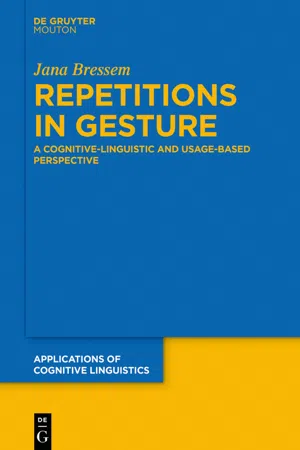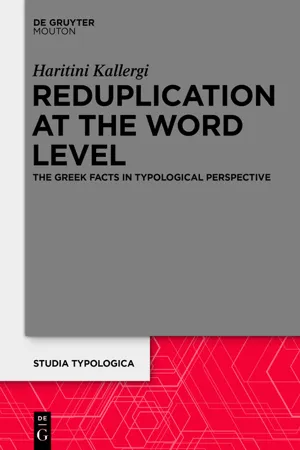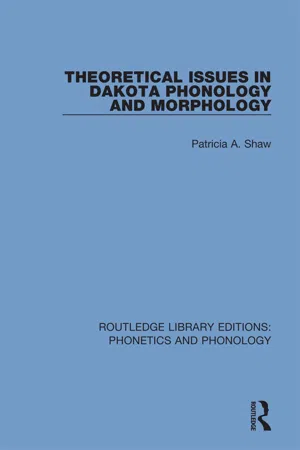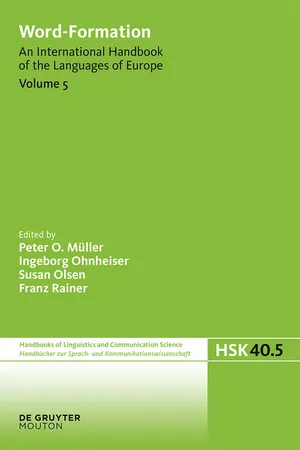Languages & Linguistics
Reduplication
Reduplication is a linguistic process that involves repeating all or part of a word to create a new word with a different meaning. It is found in many languages and can serve various functions, such as indicating plurality, intensifying meaning, or forming new words. Reduplication can be full or partial, and can occur at the beginning, middle, or end of a word.
Written by Perlego with AI-assistance
6 Key excerpts on "Reduplication"
- eBook - ePub
Repetitions in Gesture
A Cognitive-Linguistic and Usage-Based Perspective
- Jana Bressem(Author)
- 2021(Publication Date)
- De Gruyter Mouton(Publisher)
Similarly, Brandstetter (1917) accounts for Reduplication within a holistic approach covering the full range of repetition. The first systematic study on Reduplication in Indo-European languages providing a systematization of its distinct meanings is found in the work by Gonda (1950). After that, works on Reduplication became rare (Moraycsik, 1978 ; Wilbur, 1973). Yet interest in the phenomenon has risen again over the past three decades (see edited volumes by Hurch, 2005 ; Kouwenberg, 2003). 8 Current accounts thereby fall within two positions: 1) formal and semantic/functional approaches considering Reduplication to be a process of copying features from one constituent to another (e.g., Gil, 2005 ; Hurch & Mattes, 2005 ; Mattes, 2014 ; Rubino, 2005 ; Schindler, 1991 ; Stolz, 2007 a; Stolz et al., 2011 ; Wiese, 1990) and 2) inherently semantic approaches, neglecting the transference of features while assuming general independence of the individual constituents (Inkelas & Zoll, 2005). The following overview on Reduplication in spoken languages focuses on transference approaches as it is argued throughout the book, that a combination of form-based, semantic as well as functional characteristics not only offers a sound basis for the discussion of Reduplication in gesture, but also the grounds for a comparative perspective of the phenomenon in spoken and visual signs. Reduplication, which is the repetition of morphological bases (Haspelmath, 2002), is considered to be a process of word formation. 9 Two basic types of Reduplication can be distinguished, i.e., full vs. partial Reduplication. 10 “Full Reduplication is the repetition of an entire word, word stem […] or root.” (Rubino, 2005, p. 11) In cases of partial Reduplication, a part of the base is copied - eBook - ePub
- Rita Finkbeiner, Ulrike Freywald, Rita Finkbeiner, Ulrike Freywald(Authors)
- 2018(Publication Date)
- De Gruyter Mouton(Publisher)
In general, a common solution is to say that Reduplication is a morphological operation and thus applies below the word level, and that repetition is a process that applies to words and larger units. However, in some cases of repetition of full words it is still possible to claim that the result is one word, so such cases would be classified as Reduplication as well. In addition, Reduplication being a part of the grammar is rule-governed, so it is obligatory in some contexts but impossible in others (Stolz and Levkovych, this volume). One such constraint on Reduplication is the number of copies: Reduplication only allows for two copies, while repetition is unconstrained in this respect. Finally, Reduplication has to have a semantic (denotational) contribution, and usually marks verbal aspect, nominal plurality, distributivity, adjectival intensification, and also verb-noun derivation, while repetition only has pragmatic/emotional effects and thus falls outside grammar strictly speaking.Stolz et al. (2011: 57–58) discussed a possible counterexample to some of the criteria above, from the Portuguese-based Creole Angolar, where Reduplication can apply below word level, and has a clear semantics (intensification, distributive, and durative); however, it can produce more than two copies, cf. (1 ). Stolz and Levkovych (this volume) offered a solution to this puzzle: the three (or more) copies are the result of Reduplication (which produces two copies and has a semantic contribution) combined with word-internal repetition (which produces an additional copy and has an emotional contribution).This solution allows saving some of the criteria for distinguishing Reduplication and repetition, but it is based on the assumption that repetition can apply word-internally and thus also opens the possibility that Reduplication can apply outside morphology. The main criterion for distinguishing between repetition and Reduplication is then semantics. Thus instances of total Reduplication of fully inflected words as discussed in Stolz et al. (2011) can still be analyzed as Reduplication as long as they have the appropriate meaning.There is another formal criterion distinguishing repetition and Reduplication that I have not discussed so far: adjacency. According to Stolz et al. (2011) the copies of the reduplicated unit have to be adjacent; a single syllable was the only element that was sometimes allowed to intervene between the copies. However, some other researchers are more liberal in their definition and allow for non-adjacent copies without any special constraints (Inkelas and Zoll 2005). If one accepts non-adjacent copies and also accepts the idea that Reduplication is not constrained to morphology, then instances of syntactic doubling (Kandybowicz 2007) seem to also fall under Reduplication. Stolz et al. (2011) argue strongly against this view, and I will review some of their arguments when discussing the relevant RSL data.68 - Morton Ann Gernsbacher, Sharon J. Derry, Morton Ann Gernsbacher, Sharon J. Derry(Authors)
- 2022(Publication Date)
- Routledge(Publisher)
Reduplication and the Arbitrariness of the SignTerry Regjer [email protected]Department of Psychology; University of Chicago 5848 South University Avenue; Chicago, IL 60637 USAAbstract
The meanings expressed by Reduplication, or linguistic doubling, are similar across a wide array of languages. Interestingly, some of these shared meanings do not concern doubling, repetition, or plurality. This non-arbitrariness of the sign may be attributable to the interplay of two forces: iconicity, and conceptually-based semantic extension. Cross-linguistic evidence supporting this account is presented. More generally, this paper argues that the interaction of iconicity and semantic extension constitutes a potentially powerful source of nonarbitrariness in the mapping between sound and meaning.Introduction
While the relationship between sound and meaning in language is largely arbitrary (de Saussure, 1966), there are exceptions to this general rule. One of these can be found in Reduplication, or linguistic doubling. While this form expresses an array of meanings cross-linguistically, there is a core set of meanings which recur so frequently and in so many languages as to demand explanation.Consider for example the English words dum-dum, claptrap, nitwit, and riffraff. These words have two things in common: a reduplicative form, and an element of contempt in the meaning. One can also cite examples such as arbitrary-shmarbitrary, based on a productive borrowing from Yiddish. Moving further linguistically afield we find Uzbek ikir-chikir (petty, trivial, idle) and Farsi chart-o-part (irrelevant talk, nonsense), among many others. This phenomenon is intriguing because the connection between contempt and doubling is not an obvious one.Other senses that recur cross-linguistically include small , scatter , lack of control , plurality , intensity , affection , baby , continuity , and completion- eBook - ePub
- Haritini Kallergi(Author)
- 2015(Publication Date)
- De Gruyter Mouton(Publisher)
Inkelas & Zoll 2005: 3 ), it is morphology, rather than syntax or semantics that motivates Reduplication in MDT. Reduplication occurs for morphological purposes. These purposes can be either that a specific meaning is intended or that the Reduplication creates a stem type which is necessary for another morphological process. In this sense, TR or PR are ordinary morphological constructions or word formation processes.As a morphological phenomenon, Reduplication precedes phonology, in that phonological rules apply after the double selection of a morphological constituent. Thus, phonological identity is an epiphenomenon of the morphological purpose of Reduplication (Inkelas & Zoll 2005: 22, 203 ). Under this light, Inkelas & Zoll claim Reduplication to be distinct from phonological phenomena, such as rhyme, alliteration and other stylistic devices, with which it has been compared (e.g. Kiparsky 1973 mentioned in Inkelas & Zoll 2005: 204 ).3.2.5 Minimal Reduplication (Kirchner 2010 )According to Kirchner (2010) , Reduplication is minimal in that it does not require the total copying of a base and ends up as partial copying in the surface form (in this sense, maximal, as in Steriade 1988 ); it is rather emergent, i.e. arising either for morphophonological reasons (as a repair process) or due to a minimal specification for copying in syntax. It also emerges without the necessity of Reduplication-specific rules (in accordance to the economy principles of Minimalism, Chomsky 1995).Kirchner redivides the cake of Reduplication (usually sliced up into the Total and Partial types), into three categories: phonological, morphological and syntactic Reduplication. The former two types basically occur for phonological purposes, i.e. in order to achieve an appropriate (unmarked) phonological representation in line with a phonological or morphological rule. “Syntactic Reduplication” (SR), which is of interest to me, is genuinely contrasted to the other two types, because it refers to the copying of a syntactic node that is already associated with a phonological representation, which is spelled out twice (or more than twice, in case of multiple copies). In any case, Reduplication involves copying either in the phonology or in the syntax (Kirchner 2010: 26, 76, 166 - Patricia A. Shaw(Author)
- 2018(Publication Date)
- Routledge(Publisher)
CHAPTER 6: Reduplication0.Introduction :The focus of this chapter will be to characterize the Word Formation Rule (WFR) of Reduplication (REDUP) in the various dialects of Dakota and to investigate the form and relative ordering of the various phonological rules that affect reduplicated forms. The theoretical implications of the proposed analysis to various hypotheses regarding the place and function of a morphological component and universal constraints on phonological rule ordering are discussed in the appropriate sections.1.Morphological functions of REDUP .The major REDUP process to be considered is that which applies to verbal roots. In such cases, REDUP has one of a number of possible morphological functions.1.1. First, it may serve to mark the plurality of an inanimate subject, unless the subject is already modified by a numeral or a plural quantifier. (Plurality of an animate subject is marked by a verbal agreement suffixThe following data exemplify REDUP functioning to mark plurality:In the Teton dialect described by Taylor (1976: §10-4 ff.) and in the Sioux Valley dialect, plurality of [+animate], but [-human] subjects is frequently marked both by REDUP and by the suffix =pi:However, this double plural marking is not obligatory, at least not in the Sioux Valley dialect, for there are alternate forms for [+animate, -human] subjects where pi alone is used, e.g.:1.2 . A second morphological function of Reduplication is to signify an iterative or repetitive action (Teton data from Taylor 1976: §10-5):Reduplicated numbers also signify iteration:1.3. A third morphological function of Reduplication is to indicate a distributive action or state:1.4. Fourthly, Reduplication marks intensification :Given this multiplicity of possible semantic values for a reduplicated verb root, it is not suprising that ambiguity may result. For example, from the stem ba+ksá ‘to cut (a stick) in two,’ the reduplicated form ba+ksá+ksa- eBook - ePub
- Peter O. Müller, Ingeborg Ohnheiser, Susan Olsen, Franz Rainer, Peter O. Müller, Ingeborg Ohnheiser, Susan Olsen, Franz Rainer(Authors)
- 2016(Publication Date)
- De Gruyter Mouton(Publisher)
. Numeral ReduplicationNumerals are reduplicated to show distribution. In Reduplication both components take suffixes, either standard CTat. -(ş)Ar (-Ar after consonant stems and -şAr after vowels), e.g., birer-birer ‘one by one’ or ND -lAy , e.g., birley-birley ‘one by one’. The adverb az ‘little, few’ is also reduplicated in this way to express distribution, i.e. azar-azar ‘little by little’, in addition to its normal full Reduplication az-az ‘quite little, quite few’.5.4. Verb Reduplication
Full Reduplication of verbs, both finite and converbs, is employed to express reiterative or durative action, e.g., çapa-çapa ‘(he) is running and running’, ayttı-ayttı ‘(he) spoke and spoke’, süyreklene-süyreklene barıp , yuvasına kirdi ‘it crawled and crawled, then entered its burrow’. It is quite often that verbs are repeated three times, e.g., Kete kete keteler ‘They go, go, and go’.5.5. Interjection Reduplication
As a class of words that denote emotions, interjections are very often repeated two and three times, e.g., Vay-vay ! or Vay-vay-vay! ‘Oh! Alas!’. There are many reduplicated exclamations to call or drive away birds and animals, e.g., Çip-çip! ‘Cheep! Cheep!’ (calling hens and chickens); Küş-küş! ‘Shoo, shoo!’ (driving away hens and chickens).6. Blending
Blending is encountered in words which emerged from pronouns, demonstrative adjectives and light verbs, e.g., qaytip ~ qatip ‘how; lit. how-doing’ (← qalay etip ), şaytip ‘so; lit. so-doing’ (← şulay etip ), netip ‘how; lit. what-doing’ (← ne etip ), in Tatar of Turkey also bulaytíp ‘in this way’ (← bulay etip ), şulaytíp ‘in that way’ (← şulay etip ), olaytíp ‘id.’ (← olay etip ) (Yüksel 1989: 56).In the northern dialect there are demonstrative pronouns bol ‘this’ (← bu-ol ) and şol ‘this one’ (← şu-ol ) that emerged as a result of blending, and in the southern dialect such forms as able ‘in this way’ (← *ana böyle ) and abu ~ avu ‘this one’ (← *ana bu ).Crimean Tatar also displays the blending of some verbs, e. g., ekel- ‘to bring’ (← alıp kel- ‘to take and come’) and eket- ‘to take away’ (← alıp ket-
Index pages curate the most relevant extracts from our library of academic textbooks. They’ve been created using an in-house natural language model (NLM), each adding context and meaning to key research topics.
Explore more topic indexes
Explore more topic indexes
1 of 6
Explore more topic indexes
1 of 4





